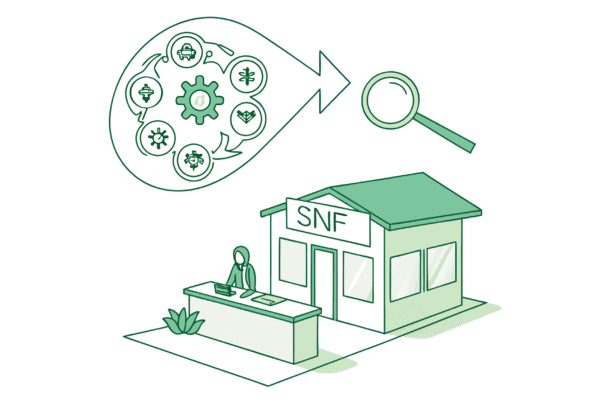If you own a hospice care practice in Charlotte, North Carolina, you are in a strong position. The demand for compassionate, end-of-life care is growing, and the Charlotte market is well-established and active. This guide provides key insights into the current landscape, what buyers look for, and how to navigate the sale process. Understanding your options is the first step toward making a decision that aligns with your personal and financial goals.
Market Overview
The market for selling a hospice practice in Charlotte is supported by strong tailwinds at the national, state, and local levels. This creates a favorable environment for practice owners who are considering a transition. The current climate is defined by a few key characteristics.
- National Demand is Growing. The U.S. hospice market is projected to grow from nearly $30 billion in 2024 to over $39 billion by 2030. With Medicare hospice utilization now over 51%, the need for quality providers is undeniable and increasing.
- North Carolina’s Market is Stable. The state has a well-established and regulated hospice industry. This stability is attractive to sophisticated buyers, as it reduces uncertainty and demonstrates a mature healthcare ecosystem.
- Charlotte is a Developed Hub. The presence of major providers in Mecklenburg County confirms that Charlotte is a recognized center for hospice care. Buyers are often looking to acquire practices in such proven markets.
These factors combine to create a healthy demand for well-run hospice practices like yours.
Key Considerations
A strong market is a great start. Your next step is to prepare your practice for the scrutiny of a potential buyer. Buyers today look beyond the basic financials. They want to understand the quality, stability, and story of your business. Your reputation for compassionate care and your patient satisfaction scores are significant assets.
However, buyers will also focus on specific metrics. Your patient census is a primary driver of value. A common benchmark in the industry is a valuation around $60,000 per patient. Buyers will also review your referral networks, the stability of your staff, and your compliance with North Carolina’s healthcare regulations. A clean operational and financial history makes your practice a much more attractive acquisition target. Preparing this information is the foundation of a successful transition.
Market Activity
The demand for hospice practices in markets like Charlotte is translating into significant real-world transaction activity. It is not a question of if buyers are interested. It is a question of finding the right buyer for your specific goals. The current market includes two primary types of buyers.
Strategic Buyers Seeking Expansion
These are often larger healthcare organizations or other hospice providers looking to expand their footprint in the Charlotte area. They are attracted to practices with strong local reputations and established referral networks that they can integrate into their existing operations.
Private Equity Investment
A major trend in healthcare is the increasing investment from private equity firms. These groups see the stability and growth potential in hospice care. They are often looking to acquire successful practices as a “platform” to build a larger regional or national organization. They bring capital and operational resources but require a sophisticated approach to negotiation.
Knowing who is buying is critical. A structured, confidential process ensures you can create competitive tension between these different buyer types to achieve the best outcome.
Sale Process
Selling your practice is a structured process, not a single event. It begins long before a buyer is ever contacted. The first phase is preparation. This involves organizing your financials, reviewing operations, and creating a compelling narrative about your practice’s value and potential. Once prepared, the next step is to confidentially market the opportunity to a curated list of qualified buyers. This generates interest and leads to initial offers. After selecting the best offer, the most intensive stage begins: due diligence. This is where the buyer verifies every aspect of your business. This stage is where many sales encounter unexpected challenges. Proper preparation is the key to a smooth process from start to finish.
Valuation
Determining what your hospice practice is worth is one of the most important steps. While industry rules of thumb exist, sophisticated buyers use a more detailed approach. Their valuation starts with a metric called Adjusted EBITDA, not simple profit. This figure normalizes your earnings by adding back owner-specific expenses and one-time costs to show the true cash flow of the business. From there, a valuation multiple is applied.
True value is found by looking at the practice through a buyer27s eyes.
| Simple View | Sophisticated Buyer’s View |
|---|---|
| Revenue or Net Profit | Adjusted EBITDA |
| Patient Census Only | Census, Payer Mix, and Referral Stability |
| Practice History | Future Growth Opportunities |
| Owner-Dependent | Strength of the Clinical Team |
An accurate valuation tells a story supported by numbers. It is the foundation for negotiating a price that reflects the years of hard work you have invested in your practice.
Post-Sale Considerations
The final sale price is important. The structure of that sale, however, will define your future. Many owners worry about what happens the day after the transaction closes. You might not want to walk away completely, or you may be concerned about what happens to your dedicated staff and the legacy you have built. These are not afterthoughts. They are critical deal points that can be negotiated.
A transaction can be structured to include an ongoing role for you, either for a short transition or a longer-term partnership. It can also include performance-based earnouts that allow you to share in the future success of the practice. Protecting your team and preserving the culture you created can also be written into the sale agreement. A successful exit strategy is not just about getting the highest price. It is about designing a transition that meets your personal, professional, and financial goals.
Frequently Asked Questions
What is the current market demand for selling a hospice care practice in Charlotte, NC?
The market for selling hospice care practices in Charlotte is strong due to growing national demand, a stable regulatory environment in North Carolina, and Charlotte’s reputation as a developed hub for hospice care providers.
What are key factors buyers consider when evaluating a hospice care practice in Charlotte?
Buyers look beyond basic financials to assess patient census, referral networks, staff stability, compliance with regulations, and the reputation for compassionate care. A common valuation benchmark is around $60,000 per patient.
Who are the typical buyers interested in hospice care practices in Charlotte?
There are two primary buyer types: strategic buyers such as larger healthcare organizations aiming to expand locally, and private equity firms seeking to invest in stable, growing hospice practices as platforms for regional or national growth.
What is the process of selling a hospice care practice like?
Selling a practice is a structured process including preparation of financials and operations, confidential marketing to qualified buyers, receiving offers, and navigating due diligence. Proper preparation is essential to avoid unexpected challenges and ensure a smooth transaction.
How is the value of a hospice care practice in Charlotte determined?
Sophisticated buyers use metrics like Adjusted EBITDA, which normalizes earnings, and consider factors like patient census, payer mix, referral stability, growth opportunities, and strength of the clinical team. This approach provides a thorough valuation beyond simple revenue or profit.



